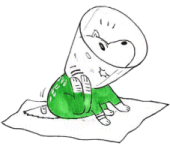|
You tried every trick in the book to keep your dog from licking and chewing but nothing seems to work. It is time to accept the inevitable: your dog needs to wear the dreaded E-collar.
Commercially made Elizabethan collars, affectionately known as E-collars, are made from hard plastic and are available in various sizes. Some are opaque and, recently, clear E-collars have become available, allowing your dog to see, and maybe, even get around better. These collars are typically available from your veterinarian or neighborhood large pet store.
What do you do if you need one in the middle of the night? You could try to contact a local emergency facility and buy one there, but be prepared to pay significantly more than at your family veterinarian’s office. Emergency clinics have a limited selection of E-collars available to sell and the convenience of middle of the night service comes with a price.
One alternative is to try to make a temporary collar at home. These makeshift ideas may sound a little funny and may look even funnier on your dog, but if it gets the job done, that is all that really matters. Your dog will eventually forgive you and once your veterinarian’s office or pet store opens, you can get an official collar.
For large dogs, consider cutting a hole in the bottom of a plastic bucket just big enough to slip your dog’s head through. Try to sand down the newly cut edges to soften the plastic or use a flame to melt the plastic and reduce sharp edges.
If you have a large cardboard box or firm poster board, you can cut an E-collar to fit your pet. Take your dog’s collar off or measure the circumference of his neck. The collar is initially a semi-circle. Draw a semi-circle in the
centre of the cardboard using your dog’s neck measurement. It will seem like this is too big but the size of the collar will reduce when you form it into a cone.
 Next, draw the outer edge of the collar. The distance from the inner semi-circle to the outer one is about ½ the measurement of your dog’s neck. Connect the two edges of the semi-circles and cut out the shape. Puncture some holes in both edges of the makeshift collar. If possible, cut out some slits near the edge of the inner semi-circle. Weave your dog’s normal collar through the slits.
Mould the cardboard into a cone and place on your dog’s head. Secure onto the neck with the neck collar. Hopefully, the holes punched in the side will line up. You can use shoestrings to lace and secure the edges together. With some patience and practice, you can make your own E-collar.
Next, draw the outer edge of the collar. The distance from the inner semi-circle to the outer one is about ½ the measurement of your dog’s neck. Connect the two edges of the semi-circles and cut out the shape. Puncture some holes in both edges of the makeshift collar. If possible, cut out some slits near the edge of the inner semi-circle. Weave your dog’s normal collar through the slits.
Mould the cardboard into a cone and place on your dog’s head. Secure onto the neck with the neck collar. Hopefully, the holes punched in the side will line up. You can use shoestrings to lace and secure the edges together. With some patience and practice, you can make your own E-collar.
|
|
A quick and easy E-collar can be made for small dogs. Take a paper plate and cut a circle out of the
centre, just big enough to slip your dog’s head through. If the plate is too big, trim down the edges. You can even remove a strip of the plate and
mould it into a cone. Use tape to secure the edges.
Once you have some type of E-collar, be prepared for some strange behaviour by your dog until he get used to it. Most pets unaccustomed to these collars will bang into furniture, walls, the floor and your legs. Some will not eat with this cone shaped thing on their head. A few may even stand in one area with the cone on the floor, waiting for this horrible thing to go away. Don’t fall for their dramatic attempts to get you to remove the collar. A few days of embarrassment and misery for your pet can reduce the risk of serious self-injury.
Fortunately, E-collars are easy to remove and place back on when necessary. If your dog is supervised, the collar can come off and he can enjoy a little freedom. Some dogs may need the collar removed each time they eat. Remember to replace it when you are not around or when you are sleeping. Most dogs eventually learn to eat, sleep and be their normal selves, even as an Elizabethan.
Article from the Pet
Place
Web Site |